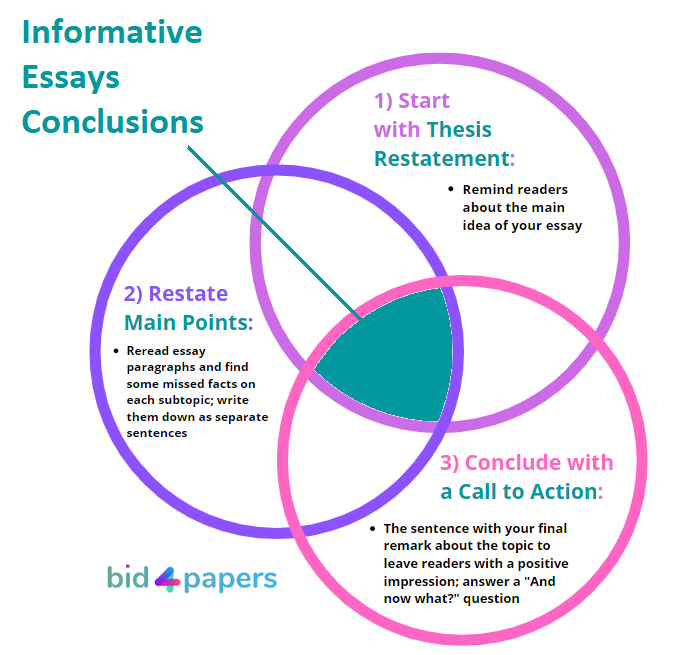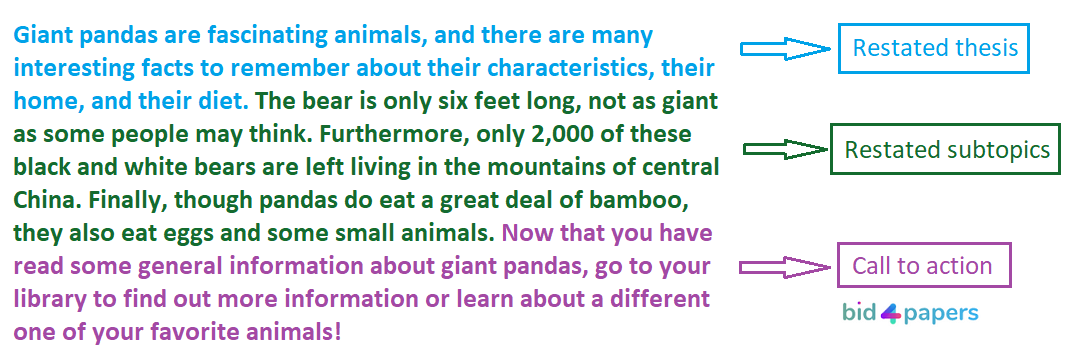
How to Write a Conclusion of an Informative Essay
- Restate a thesis.
- Wrap up subtopics.
- Leave readers with food for thought.
So now you finish the assigned paper and wonder how to write a conclusion of an informative essay. Congrats! You’re at the right place:
This guide will reveal all the details about the process: the elements of an informative essay conclusion, how to connect them to an essay body, and why end on a positive note to leave a reader with food for thought.

What is an Informative Essay Conclusion?
We nailed it a long ago in our super popular article about essay conclusions:
A concluding paragraph of your essay is as critical as its introduction. It summarizes the content, provides closure for readers to remember the main idea of your work, and leaves the audience with food for thought.
Long story short, your essay conclusion needs to answer a “What now?” question, giving the audience something to think about after they’ve read your paper.
A good essay conclusion restates a thesis and main ideas, providing a sense of closure. It concludes the thoughts you covered in the essay body, not presenting new ideas.
Tip: Try to finish your informative essay on a positive note, even if the topic itself wasn’t so. It will influence the final impression of your work. Make your conclusion short and sweet, no longer than 5-7 sentences in length.
Conclusion of an Informative Essay

Informative essay conclusions need to relate to the information in your previous paragraphs. As a writer, you have three steps to do that:
- Restate thesis statement
- Restate main ideas
- Finish with a call to action
Let’s reveal more details on each one!
P.S. For better clarity, we’ll use a well-known example with pandas. (Remember we addressed it in other blog posts about informative essays?
Restate Thesis Statement
A thesis statement should remind readers about the main idea and subtopics of the essay they’ve just read.
We bet you remember the formula for writing a thesis statement in informative essays: main topic + subtopic 1 + subtopic 2 + subtopic 3, connected in one sentence using correct grammar. When writing about introductions, we used this thesis statement example:
- Giant pandas have special characteristics, live in certain areas of China, and eat food besides just bamboo!
A key aspect to remember when writing a conclusion: Never use the same sentence twice in an essay. What you need to do is take the same ideas but restate your thesis statement in an interesting way yet with the same information.
Look:
- Giant pandas are fascinating animals, and there are many interesting facts to remember about their characteristics, their home, and their diet.
Here we have the same subtopics (characteristics, home, and food), and yet they are not the same but rewritten a bit.
Once again, a big thank goes to Mr. S from YouTube for his panda examples!
Restate Main Ideas
Now it’s time to restate your main ideas by using essay body paragraphs.
Your first paragraph was about giant panda’s special characteristics:
Reread it to remind yourself what you’ve already covered because (again!) you don’t want to use the same fact twice in your paper. Then, go back to your informative essay outline and check which fact is missed but still worth using for an essay. Let’s say, you might forget to include the info about giant pandas’ size:
- The bear is only six feet long, not as giant as some people may think.
So, you take this fact and write it down in your essay conclusion.
Then, go to your essay body’s second and third paragraphs to do the same: Reread them and make sure the second and third restatements of your main idea answer the subtopics coved in those paragraphs.
For example, you could mention the following information about giant pandas’ homes and diet:
- Only 2,000 of these black and white bears are left living in the mountains of central China. (To remind readers that many pandas are left, so we need to be careful with what we have left on earth.)
- Though pandas do eat a great deal of bamboo, they also eat eggs and some small animals. (To remind readers that pandas don’t only eat bamboo, which is the most common thing people know about these wonderful creatures.)
Now you’re done with the restatement of the main ideas, and it’s time to move to the last part of your informative essay conclusion.
Finish with a Call to Action
While there are many ways to finish a paper, a compelling call to action works best for informative essays.
If you left a paper just as it is, with a restated thesis and main ideas, it would sound a bit awkward. A concluding sentence of your essay should provide a sense of closure and answer the “And what now?” question the audience might have after reading your work.
A few variants of calls to action for your informative essay about pandas could be as follows:
- Now, go read more about pandas! (Well, this one is super boring and simplistic.)
- Now, it’s time to schedule a visit to a nearby zoo that has one of these amazing animals. (This one is better, providing readers with some thought.)
- Now that you have read some general information about giant pandas, go to your library to find out more information or learn about a different one of your favorite animals! (Let’s stay with this one.)
That said, here’s what your informative essay conclusion would look like if you wrote about giant pandas:

As you’ve probably noticed, we’ve added a few linking words to the conclusion (“furthermore” and “finally”) to give it a natural flow and make the whole paragraph sound better.
In a Word
Like other essay types, informative papers need a conclusion that would summarize the main points and leave a reader with a positive impression and food for thought. So, when you wonder how to write a conclusion for an informative essay, follow these three steps:
- Restate your thesis statement (the same thoughts with other words)
- Restate main ideas (subtopics you covered in body paragraphs)
- Finish with a call to action (What should the audience do after reading your work? Please think of encouraging them to get involved in something for further knowledge or research.)
Any questions left? You can always contact our writers, or feel free to leave a comment in the section below!